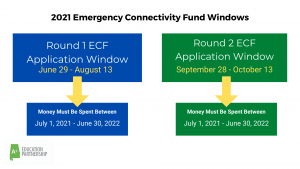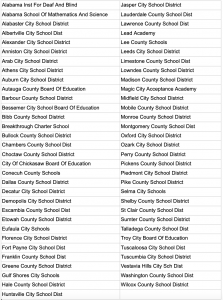Over $3 billion is coming to Alabama schools from the three rounds of federal funding in order to address the challenges resulting from the COVID-19 pandemic. Schools and districts have an unprecedented amount of money at their disposal to improve student outcomes, and we are keeping families, communities, and decision-makers up-to-date on best practices and tracking district spending priorities. This is part 3 of our COVID School Spending series.
Many inequities came to new light during the COVID-19 pandemic, but one of the most glaring has been the lack of equitable access to internet connectivity and devices. While most schools in Alabama have returned to offering in-person classes, students and teachers are still quarantining on an as-needed basis due to the recent surge of COVID cases because of the Delta variant, with over 3,802 reported cases across the state just last week (September 20-24, 2021). This means many students are still engaging in remote or virtual learning from home. Estimates of the number of Alabamians without broadband connectivity range from 608,000 to 1.2 million. In order to keep students on track and catch students up from multiple years of disrupted learning, improving access to internet services is critical.
Emergency Connectivity Fund: Apply Now
The Emergency Connectivity Fund, or ECF, is a Federal Communications Commission (FCC) program that will provide up to $7.17 billion for schools and libraries to provide resources for students as they continue their education through the pandemic. Like Elementary and Secondary Schools Emergency Relief (ESSER III), the ECF is part of the American Rescue Plan (ARP), but it is distributed to schools and libraries through the FCC rather than through state education agencies.
Who is eligible?
Schools that are part of the FCC E-Rate program are eligible to apply. Schools and libraries outside of the FCC E-Rate program are also eligible for ECF funding, but will be required to provide additional documentation.
How can my district apply?
The FCC has decided to open a second application window, which will be September 28 through October 13. Eligible schools and libraries will be able to submit requests here for reimbursements on purchases made from July 1, 2021 through June 30, 2022. The ECF website has a multitude of resources, including a module on how to fill out the application, as well as program flyers, a helpline, and a catalog of previous webinars on various ECF topics.
How can this money be used?
Eligible equipment and services include:
- Laptops, tablets, and connected devices
- Wi-fi Hotspots
- Modems
- Routers
- Combined Modems and Routers
- DSL Internet
- Fiber Internet
- Wireless Internet (mobile broadband)
- Satellite
- Cable
The linked document above also lists out ineligible uses of ECF dollars.

Ongoing State Efforts to Expand Broadband Access
Last school year, Governor Kay Ivey allocated a total of $248 million in CARES Act funding to advance student connectivity and build capacity for remote learning:
- $100 million for Alabama Broadband Connectivity (ABC) for Students: provided vouchers for home internet service to families that qualified for free or reduced lunch through June 30, 2021
- $100 million for digital devices: districts received a minimum of $100,000 to purchase devices and virtual learning software. Find your district’s allocation here.
- $48 million in GEER funding to equip school buses with WiFi, provide digital textbooks, library resources, and additional academic support, and before and afterschool tutoring. Read her press release on GEER funds here.
The Alabama Legislature also took action in the 2021 regular legislative session to expand broadband connectivity with the creation of the Alabama Digital Expansion Authority, created to develop and execute a connectivity plan for rural Alabama, as well as oversee a grant program to place high-speed broadband networks across the state. Alongside this is the creation of the Alabama Digital Expansion Finance Corporation, which can issue bonds to fund broadband expansion across the state. You can read more about these new organizations here.
These steps begin to address the digital divide in Alabama, but for schools and districts that need more immediate help to connect their students, the Emergency Connectivity Fund will also be an important source of support.
So What: Takeaways for Families and Communities?
Following 3 rounds of federal funding targeted toward remote learning and pandemic recovery, many districts have already put a significant amount of money towards devices. However, as the pandemic continues, needs for connectivity still exist. The following is a list of questions to help parents and leaders determine if applying for ECF funding is the right decision for their district:
I learned about the funding from the Emergency Connectivity Fund for internet services and devices. Do students in the district need hotspots or another form of internet access?
Do students need upgraded devices for certain classes, e.g. computer science or other STEM courses that might need more computing power than a Chromebook or tablet?
Will students without internet access at home be able to access online homework assignments without a hotspot or other means of internet access?
Is internet service with adequate upload/download speeds affordable for low-income families in my area?
Public Schools and Districts that Applied for first-round Emergency Connectivity Fund

To find out how much each district requested and what they are using their funds for, open this spreadsheet.

0 Comments on "COVID School Spending: New Federal Funding to Expand Internet Access"